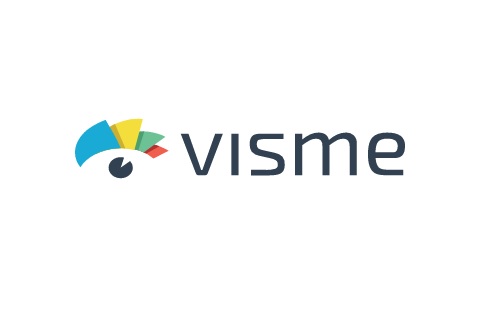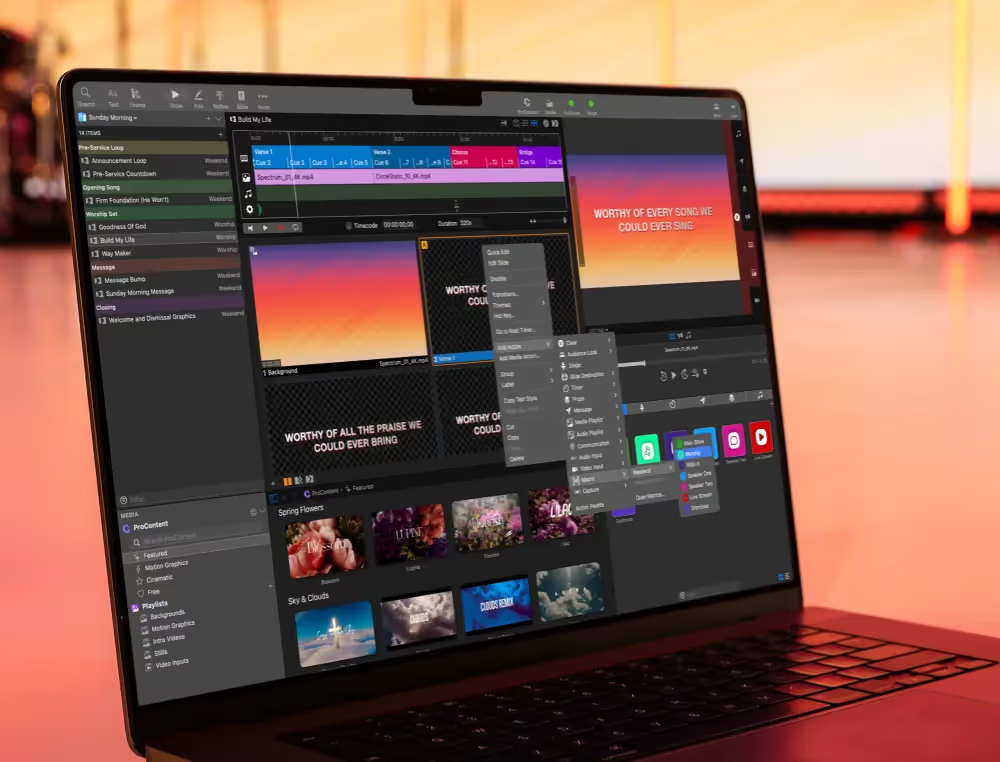Learn more Introducing the ProPresenter Lyric Banner!
Businesses of all shapes and sizes have been relying on basic, business-oriented presentation tools for several decades now. Tools like Microsoft PowerPoint and Google’s lightweight, cloud-based alternative Google Slides do an adequate job for business users that simply need to create a presentation that they can use in the conference room or over Zoom.
But there’s no question: these presentation software solutions have real limitations.
Can you use these tools to create professional business presentations? Yes—as long as your needs don’t go beyond what the tools are designed to do.
If you need to do more, then PowerPoint and its competitors start to feel extremely limiting and frustrating to use. Once you start running into the limitations of these office-oriented tools, you need to consider a different tier or category: advanced presentation software.
In this all-in-one guide, you’ll learn everything you need to know about advanced presentation software—and how to make the right choice among advanced presentation tools for your business.
Let’s start by defining our terms: What exactly do we mean by “advanced presentation software”?
What Is Advanced Presentation Software?

Advanced presentation software is our term for any presentation solution or PowerPoint alternatives that can do things PowerPoint and its clones can’t. This may mean handling live streaming functions, more robust video capabilities, support for multiple inputs and outputs, or any other advanced features not present in basic presentation apps.
In other words, advanced presentation tools are any product that fills in the statement “Oh, you’ll need ____ for that instead of PowerPoint”—and that also delivers the same core abilities as PowerPoint.
How to Select the Best Advanced Presentation Tools for Your Business
Now, our category definition is admittedly a little broad, and so are the options you’ll find in this category. Each solution has its own focus, and some of them can look quite different from each other.
We’ll get to some rankings in a bit, but first: follow these four steps to refine your search and have a clearer idea which direction to go.
1. Define your specific needs

First up, take the time to define exactly what you need your advanced presentation software to do. This starts with the limitations in PowerPoint that brought you to this point: what are you trying to do that PowerPoint can’t handle (or doesn’t handle well)?
This singular pain point is important and it’s your starting point—but don’t make the mistake of stopping there.
Not every presentation solution on the market offers the same capabilities. So if you stop with the main pain point you could end up with a solution to that pain point that creates new ones.
Here’s an example: say your primary pain point is live streaming: you want to be able to go live from within a presentation app rather than string together two or three or four apps.
There are plenty of live streaming solutions out there that can solve your primary pain point. But some of them don’t include capable slide design or graphic design tools. Assuming you still serve as an interactive presenter and need to build traditional presentations, you could solve your primary pain point and create new headaches at the same time.
All that to say: take the time to list out all your specific needs. This list starts with the capabilities you’re missing in your current solution, but it should also include everything else you regularly need your advanced presentation tools to do.
Here are a few capabilities that might need to show up on your list of needs:
- Support for multiple unique outputs
- Support for rich, complex audio and video media
- Live streaming and recording capabilities: can the software do this itself, or does it interact well with your existing live stream setup?
- Allows edits on the fly
- Low learning curve: do you have dedicated A/V pros running the show, or do you need something volunteers can run with minimal training?
2. Inventory current hardware and equipment

Next up is taking inventory of your current hardware and equipment.
Why? Because the more advanced your A/V capabilities (and needs), the more complex your current hardware and equipment setup is.
If your only equipment is a conference room projector and a laptop, then PowerPoint is probably more than capable. But as your A/V setup grows in complexity, you could start running into compatibility issues.
Build an inventory of your can’t-live-without-it hardware and equipment. Then ensure that tech is compatible with whatever advanced presentation software you’re considering.
Here’s an example: some of the big advanced presentation solutions are PC-only. If you’re operating on a Mac (or in an IT environment that mixes Apple and PC products), those solutions are a nonstarter.
You could encounter similar compatibility issues with audio and video inputs and output formats, external capture equipment and hardware encoders, and more.
3. Narrow down your options
With your list of needs and an inventory of your current equipment and setup, you’re ready to narrow down your options. We’ll show you some of the best options on the market today in the next section, and you might already have certain products in mind or on your list.
As you consider each option, start with those two lists:
- Does this advanced presentation software solve your pain points and meet your existing presentation needs?
- Does this solution work well with the equipment and hardware you’re already using?
These two questions will help you quickly cross options off your list—and give you greater clarity about the options that are best for your context and needs.
4. Consider future needs

In addition, give a bit of thought to future-proofing. Are there capabilities or use cases that you don’t need right now but that you might reasonably need in the future? Switching to a new presentation solution is an investment (even the best solutions have a learning curve), and you don’t want to be right back here in a couple of years.
The Best Advanced Presentation Software Solutions, Ranked
These are the best advanced presentation tools on the market today. Each of them significantly outperforms PowerPoint while still delivering the kinds of customization options, designed templates, and drag and drop editing you know and love.
(Quick note: these are our rankings for advanced business presentation apps. If you’re looking for solutions specifically geared for churches and houses of worship, we’ve got you covered with another in-depth guide.)
1. ProPresenter

ProPresenter is an industry-leading advanced presentation tool that delivers the powerful capabilities that professionals needs across businesses and industries. Events professionals, live event venues, and businesses that need a higher degree of polish than they can get from PowerPoint all trust ProPresenter for their presentation, video, and live streaming needs.
ProPresenter includes an advanced slide editor that allows users to drag and drop assets into locations and layers of their choosing. The editor gives users a wide range of customization options whether they want to start with designed templates or build their own.
Thanks to the seven-layer slide architecture, ProPresenter offers a capability that’s unique among its competitors: you can send as many unique outputs as you need. Could you use a presenter view that’s different from the main feed? What about a lobby feed or a unique version of your content for live stream?
With ProPresenter, your hardware is the only limitation. Output whatever you need to wherever you need it—all independently configurable from your other outputs.

2. Visme

Visme is another high-quality choice for advanced presentation software. Like ProPresenter, Visme sets out to do more than just replace PowerPoint. But the focus here is less on advanced visuals and live streaming and more on the office ecosystem: Visme pulls your documents, videos, data visualizations, graphics creation, and presentations all into a single hub.
Building powerful visuals (including data visualizations) is easy in Visme, and incorporating those into your presentations is straightforward. But before you jump on the Visme train, ask yourself (and your team) whether moving documents out of Word or Docs and into something new and unfamiliar is a move your business wants to make.
The other drawback here is that since Visme runs in a web browser, there’s no chance of multiple outputs or advanced audio and video routing.
3. Haiku Deck

Originally a pitch deck builder, Haiku Deck bills itself as the easiest solution to building presentations from any device. The adaptive slide designer is attractive for organizations that don’t want to think about the details but just want them to look good. Add a few elements to a slide, and Haiku Deck will give you multiple suggestions for how to finish it out.
These kinds of “intuitive editors” are popping up more and more, but they’re a double-edged sword: if they work perfectly for you, they’re amazing. But if they don’t, you’re in for a frustrating experience.
In this category, we think Haiku Deck finds the best balance. You do give up some granular controls, but you aren’t completely locked out of fine-tuning, either.
4. Zoho Show

Zoho Show is unique among those on this list: it’s completely free. Zoho wants to pull users into its broader business suite and uses free Zoho Show as a tool for doing so.
For a freebie, Zoho Show is impressive. It’s web-based and enables real-time collaboration. The clean interface can automate your designing to a degree, and the wide range of designed templates and free assets will make your presentations look professional.
Zoho Show doesn’t handle live video and won’t give you control over outputs. But if you don’t need those capabilities, it’s hard to argue with the price.
5. Pitch

The newest solution on this list is much closer in functionality to PowerPoint but has been dubbed the “PowerPoint killer” because of its intuitive interface and superior design tools. Its design capabilities are strong, and the cloud-based app takes a dual-tiered approach. Non-designers will find intuitive, semi-automatic controls, while designers can access deep customizations under the hood.
Where Pitch excels is in the execution: intelligent design assistance keeps presentations looking beautiful, while built-in project management capabilities let you delegate and track work. Keyboard and menu shortcuts help you operate faster, and you can import rich media from sources like Loom, Vimeo, YouTube, Giphy, and more.
If you’re looking for the same essential feature set as PowerPoint, just better and more intuitive, Pitch is absolutely worth a look. With a free version (the starter plan) and a pro version at just $8/user/month, Pitch offers a lot of power for not a lot of money.
However, if you’re looking for a tool that lets you do things PowerPoint can’t do, Pitch doesn’t have a whole lot to offer.
Start Your ProPresenter Trial Today

If you’re looking for the most powerful advanced presentation tool that can outperform PowerPoint in all its core services—and that offers a next-gen approach to multiple display outputs—then nothing beats ProPresenter.
Businesses with advanced A/V needs trust ProPresenter to run their visuals flawlessly—even when those visuals involve complex inputs like live video or complex, varied outputs.
Want to see if ProPresenter is the right choice for your business? You can do so right now with an unrestricted two-week trial. There’s no obligation, and if ProPresenter doesn’t blow you away, you’re free to move on and try something else.
Ready to get started? Start your unrestricted trial of ProPresenter today!
By subscribing, you agree to our Terms and Conditions.
Experience the power of ProPresenter
Take your production to the next level with ProPresenter's intuitive suite of tools.

Stay Updated with Our Newsletter
Get the latest news, updates, and exclusive offers delivered straight to your inbox.

Questions?
Browse our FAQs or our Knowledge base that we’ve made to answer your questions. Need additional help? Connect with a support team agent!

.png)
.avif)